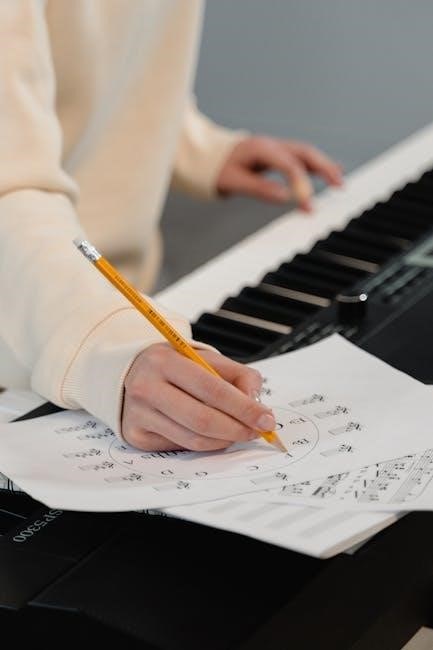Violins come in various sizes, determined by age, height, and arm length. Proper fit ensures comfort and playability, making it essential to choose the right size for optimal performance.
Why Violin Size Matters
Violin size significantly impacts comfort, playability, and sound quality. A properly fitted instrument ensures ease of use, while an ill-fitting one can cause discomfort or difficulty in playing. Arm length and body proportions are key factors in determining the right size. Incorrect sizing can lead to poor posture or technique, potentially discouraging practice. Proper fit allows for optimal sound production and ease of handling, making it essential for both beginners and experienced players to select the appropriate size. This ensures a positive and enjoyable musical experience.

Understanding Violin Sizes
Violins come in various sizes, from full-size (4/4) to fractional sizes like 1/16. Size is determined by age, height, and arm length, ensuring proper fit for comfort and technique.
Full-Size Violins (4/4)
The full-size or 4/4 violin is the standard size for adult players and advanced students. It measures approximately 14 inches in body length and is recommended for individuals with an arm span of around 23 inches or more. This size ensures optimal sound quality and playability, making it the most common choice for professional musicians. Proper fit is essential, as a full-size violin may be too large for younger players, causing discomfort or technical difficulties.
Fractional Sizes (1/16, 1/8, 1/4, 1/2, 3/4)
Fractional violins are designed for younger players, with sizes ranging from 1/16 to 3/4. These smaller instruments are tailored to fit children’s developing bodies, ensuring comfort and proper technique. The 1/16 size is the smallest, suitable for very young children, while the 3/4 size bridges the gap to the full-size violin. Each fractional size is determined by arm length and body proportions, allowing students to graduate to larger instruments as they grow. Teachers often recommend these sizes to ensure a proper fit and encourage smooth progression in learning.

How to Measure for the Right Violin Size
Measure arm length from the shoulder to the wrist and compare it to a size chart. Ensure proper body positioning to determine the ideal fit for comfort and playability.
Measuring Arm Length
To determine the correct violin size, measure your arm length from the shoulder to the wrist. This helps ensure the violin fits comfortably and allows proper playing posture. For children, this measurement is crucial as it accounts for growth. Adults should also consider their body proportions. The ideal arm length aligns with the violin size chart, ensuring the elbow rests at a 90-degree angle while holding the instrument. Proper measurement prevents discomfort and ensures optimal playability. Always consult a size chart or a professional for accurate fitting.
Measuring Body Position
Proper body positioning is crucial for comfortable violin playing. The violin should rest on the left shoulder and chest, with the neck tilted slightly downward. The scroll should be near the left ear, allowing easy access to the strings. Use a shoulder rest to support the instrument and maintain proper posture. Ensure the violin fits snugly against the body without causing strain. Correct body positioning prevents discomfort and ensures optimal playability, making it easier to hold and maneuver the instrument during performances.

Determining the Right Size for You
Determining the right violin size involves considering age, height, arm length, and body proportions. Proper fit ensures comfort and playability, making it essential to choose carefully for optimal performance.
Violin Size for Children
Choosing the right violin size for children is crucial for proper technique and comfort. Violins come in fractional sizes, such as 1/16, 1/8, and 1/4, tailored to fit smaller bodies. These sizes ensure the instrument is proportional to the child’s height and arm length, making it easier to play. Measuring arm length from the shoulder to the palm helps determine the appropriate size. A well-fitting violin allows children to hold the instrument correctly, with the elbow forming a 90-degree angle. Parents should consult a teacher or use a size chart to ensure the best fit for their child.
Violin Size for Adults
Adults typically use a full-size (4/4) violin, but proper fit depends on individual height, arm length, and body proportions. Measure arm length from the shoulder to the palm to determine comfort. Petite adults may prefer a slightly smaller instrument, while taller individuals might find a full-size violin more suitable. Ensuring the right size is crucial for proper playing technique and comfort. A well-fitting violin allows for optimal posture and prevents discomfort during extended practice sessions. Consulting a professional can help adults choose the ideal size for their needs.
Special Cases (Petite Adults or Taller Children)
Petite adults and taller children may require tailored violin sizes. Petite adults often find smaller fractional sizes, like 7/8, more comfortable, while taller children might need a larger fractional size to accommodate their longer arms. Measuring arm length and ensuring proper posture is key. A professional can help determine the best fit, ensuring comfort and ease of play. Proper sizing prevents discomfort and supports technical development. Custom adjustments may be necessary for optimal performance and to meet individual physical needs.

Visual Guide to Violin Sizes
This section provides a size comparison chart and images of different violin sizes, from 1/16 to full-size 4/4. The chart correlates arm length measurements with corresponding violin sizes, while images illustrate the physical differences between instruments, helping players understand proportions and choose the right fit. These visuals offer a practical reference for determining the appropriate violin size based on individual measurements and growth stages.
Size Comparison Chart
A size comparison chart helps determine the appropriate violin size based on arm length and age. It lists sizes from 1/16 to 4/4, with corresponding measurements. For example, a 1/16 violin suits arm lengths of approximately 18 inches, while a 4/4 size requires about 23 inches. The chart also correlates sizes with typical age ranges, though growth rates vary. This visual tool provides a quick reference for selecting the right violin size, ensuring comfort and proper playing technique.
Images of Different Violin Sizes
Images of different violin sizes provide a visual understanding of the variations in instrument proportions. They often display violins from 1/16 to 4/4 sizes, showcasing their relative lengths and body shapes. These images help compare the instruments side by side, highlighting differences in neck length, body size, and overall scale. Many online resources and guides include high-quality photos of violins in playing position, allowing users to see how each size fits various body types. Visualizing the sizes aids in making informed decisions about the most suitable violin for individual needs.
Factors Influencing Violin Size
Violin size is influenced by age, height, arm length, and body proportions. Growth rates and comfort also play a role in determining the appropriate size for players.
Age and Growth Considerations
Age is a primary factor in determining violin size, but growth rates vary. Children grow at different paces, so arm length and body proportions are key. While age provides a general guide, measuring the player’s arm length ensures accuracy. Young players may need smaller sizes like 1/16 or 1/8. As they grow, they can transition to larger sizes. Consulting a teacher or using a measurement guide helps ensure the best fit. Proper sizing supports comfort and proper technique, making it essential to consider both age and physical development.
Arm Length and Body Proportions
Arm length and body proportions play a crucial role in determining the right violin size. Measure arm length from the shoulder to the wrist to gauge the appropriate size. While age provides a starting point, physical measurements ensure accuracy. Proper fit allows for comfortable posture and technique. Body proportions, such as shoulder width and hand size, also influence the choice. A well-suited violin supports optimal playing comfort and avoids strain. Always consult a sizing guide or teacher for precise measurement and fitting.

Selecting the Right Size
Proper fit is crucial for comfortable posture and technique. Measure arm length, consider age, and use size charts to find the ideal violin size for you or your child.
Step-by-Step Guide to Choosing Your Violin
To choose the right violin size, start by measuring your arm length from the clavicle to the wrist. Use a size chart to match this measurement to the appropriate violin size. Consider your age, as younger players typically use fractional sizes. Ensure the violin allows a 90-degree elbow bend when held in playing position. Consult a teacher or professional for guidance. Proper fit ensures comfort, technique, and enjoyment. Always test the violin to confirm it feels right for your body proportions and playing style.
Common Mistakes to Avoid
When selecting a violin size, avoid guessing based solely on age or height. Ignoring arm length measurements can lead to discomfort and poor technique. Do not assume larger violins are better; oversized instruments hinder proper playing. Avoid overlooking body proportions, as petite adults or taller children may need specialized sizing. Never skip testing the violin’s fit, as improper sizing can cause discomfort or injury. Lastly, do not ignore growth spurts in children, as this may require frequent size adjustments. Proper fit is crucial for enjoyable and effective playing.
Choosing the right violin size is crucial for comfort and proper technique. Consider height, arm length, and age, ensuring a perfect fit. Consult a professional to avoid mistakes.
Final Tips for Ensuring the Perfect Fit
To ensure the perfect fit, measure arm length from the shoulder to the palm. Choose a size that allows a 90-degree elbow bend while holding the violin. Avoid larger sizes, as they can cause discomfort and technique issues. Consult a professional fitter or teacher for guidance. Regularly check fit for growing children. Proper fit prevents discomfort and enhances playability, making practice and performance enjoyable and effective;